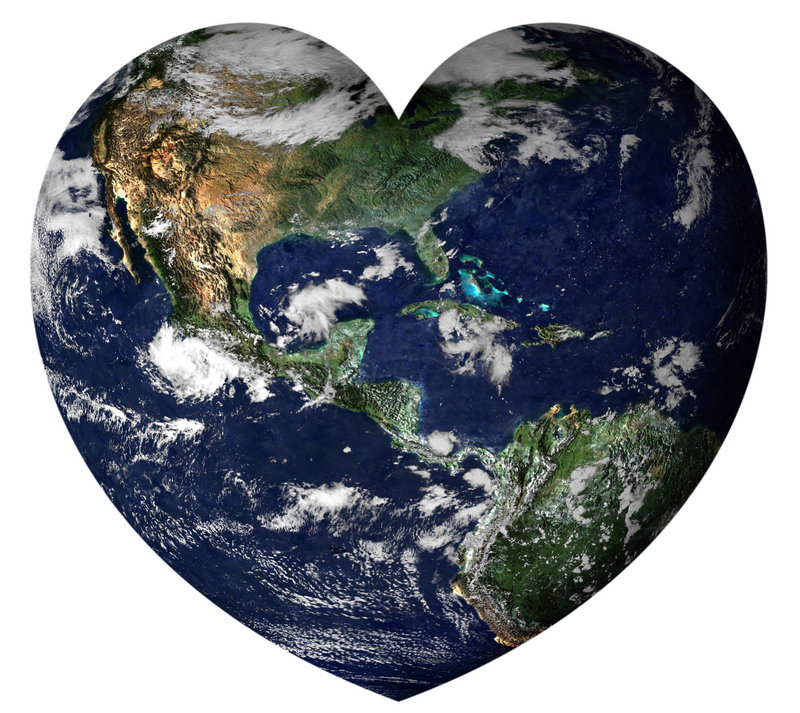In this season of gift giving and resolution making, it’s worthwhile to pause and remember our Mother. Our Mother Earth, that is. While the modern world does its best to distance us from the place we call home, there’s no denying that our health is inextricably tied to the Earth’s well-being.
When her waters run clear of contaminants, her skies blow free of pollutants and her land is unburdened by toxins, we Earthlings face less disease and death. But when we clog her ecosystems with our waste, the results show up in our health-care bills.
The ways humans impact and pollute the Earth are many and varied, but what we choose to eat plays a supersized role in the health of our planet.
Here are FOUR THINGS YOU CAN DO to make your food choices more Earth-friendly and give a gift to the planet in the new year:
1. EAT LOWER ON THE FOOD CHAIN.
Cows, chickens, pigs and other animals raised for food require a lot of resources and produce a lot of waste. If you’re someone who eats animal products every day, your food choices put a bigger strain on the planet than your kale- and quinoa-chomping neighbor. The 2006 report “Livestock’s Long Shadow,” produced by the United Nations, found that raising animals for food produced the most carbon dioxide, at 18 percent, of any industry. Even more troubling, the report found the livestock industry accounts for 37 percent of human-produced methane and 65 percent of human-produced nitrous oxide, both of which are more powerful atmosphere-warming agents than carbon dioxide.
This summer, leading water scientists at the Stockholm International Water Institute issued a blunt warning about animal agriculture’s impact on dwindling clean water supplies. Noting that producing animal foods takes five to 10 times the amount of water that growing plant foods require, the study authors urged more of the world’s population to adopt a vegetarian diet or drastically cut the amount of meat it consumes if we want to avoid massive food shortages in the future.
2. EAT FOOD PRODUCED CLOSER TO HOME.
Mainers are lucky because we live in a state with a rich farming heritage that has only grown more robust in recent years. It’s now possible — thanks to greenhouses, local food processors, winter farmers markets and winter CSAs — to buy Maine-grown food all year round. Not only do such purchases ensure that you have the freshest food and are supporting the local economy, but you also prevented that head of lettuce, tomato or apple from being shipped across the country or around the world.
In 2003, researchers at the Leopold Center for Sustainable Agriculture at Iowa State University found that the average locally grown food traveled an average of 56 miles from farm to table. In contrast, the researchers found all other food products travel an average of almost 1,500 miles from farm to table.
All those added food miles on trucks, planes and ships means more fossil fuel burned and more pollution in the air.
3. EAT FOOD, DON’T WASTE IT.
As millions around the world go hungry, millions of others routinely throw perfectly good food in the trash. The United Nations found that in an average year rich nations throw away as much food as is produced in all of sub-Saharan Africa.
The average person in the U.S. throws away between 209 and 253 pounds of food each year.
In countries like ours, more than 40 percent of food waste happens in homes, grocery stores and restaurants. People regularly throw away uneaten meals and less than picture-perfect (but still perfectly edible) produce.
To prevent excess food waste, order smaller meals, serve smaller portions and plan out your meals before hitting the market. If you must throw out food, be sure to compost it. This way it’s not totally wasted, but becomes a valuable builder of soil fertility.
4. EAT FOOD THAT DOESN’T COME FROM A FACTORY.
Whether it’s peanut butter, bagged salad greens, hamburger or chicken, food recalls due to bacterial contamination have become a regular part of life in America. The one thing the vast majority of recalls share is that the food was produced in a factory setting.
In addition to being a welcoming environment for disease, megafarms (a relative rarity in Maine) tend to use environmentally destructive farming practices, such as overgrazing, chemical fertilizers, monocropping, synthetic pesticides and a lack of cover crops.
Even more troubling from an environmental standpoint are the factory farms that raise animals. Traditional farming methods, where a few pastured animals were part of a diversified farm, create greater ecological balance by recycling animal waste into soil fertility. However, factory livestock farms have become significant sources of air and water pollution due to huge concentrations of animal waste that are too massive for the surrounding land to absorb in the form of natural fertilizer.
The nonprofit group Farm Forward, which works to end factory farming, calculates that 99 percent of the country’s meat, dairy and eggs come from factory farms. The best way to avoid factory food is to buy directly from a farm or food producer you know and trust.
Staff Writer Avery Yale Kamila can be contacted at 791-6297 or at:
akamila@pressherald.com
Twitter: AveryYaleKamila
Send questions/comments to the editors.



Comments are no longer available on this story